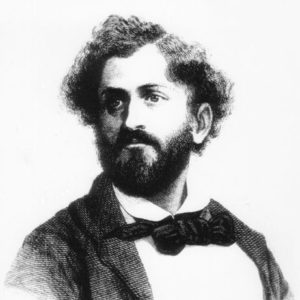calsfoundation@cals.org
Friedrich Wilhelm Christian Gerstäcker (1816–1872)
aka: Friedrich Wilhelm Christian Gerstaecker
aka: Friedrich Wilhelm Christian Gerstacker
Friedrich Wilhelm Christian Gerstäcker was a nineteenth-century author who wrote about social conditions in backwoods Arkansas before the Civil War. He visited the state from 1838 to 1842 for periods of up to eighteen months at a time. His writings—in the form of essays, short stories, and novels—provide insights into folkways, social conditions, popular religion, gender roles, and a host of other topics relating to backwoods life in Arkansas.
Gerstäcker was born in Hamburg, Germany, on May 10, 1816. He and his younger sister moved frequently as children because their parents, Karl Friedrich Gerstäcker and Luise Frederike Gerstäcker, were opera singers who moved as their roles demanded. His father died in 1825 of tuberculosis. Overwhelmed with the twin burdens of her career and raising Friedrich and his sister Molly, his mother sent the children to live with their aunt and uncle in Braunschweig.
Gerstäcker’s uncle thought that he should become a businessman and so apprenticed him to a merchant in Kassel, but at the age of nineteen, Gerstäcker announced his intention to immigrate to the United States to take up farming. As he had no knowledge whatsoever of agriculture, his mother insisted that he spend two years working on a German farm before making the journey to the U.S.
His imagination had been fired as a boy by the works of James Fenimore Cooper, and he idealized the American frontier as a place of ultimate freedom. It was not surprising that, during his five years in the United States, he never made any serious attempt to farm. Instead he wandered widely, hunted, and performed odd jobs.
After he arrived in New York in 1837, he immediately set out for the West, traveling mainly by foot to Arkansas, where he spent the first three months of 1838 hunting on the Little Red River and working as a fireman on a steamboat on the Arkansas River. For the following fifteen months, he traveled back and forth between Texas, Ohio, and Louisiana before spending another nine months in Arkansas, from May 1839 to February 1840, in Poinsett, St. Francis, and Independence counties. He traveled to Arkansas again for a two-week hunting trip on the Cache River and Bayou de View in August 1840, and then for an eighteen-month stay in 1841 and 1842, mainly along the Fourche La Fave River in Perry and Yell counties and along the Mulberry Creek in Madison County. In July 1842, he left Arkansas for Louisiana, where he spent a year before returning to Germany in the summer of 1843. All these travels were carefully recorded in a diary, which he sent home to his mother in installments in lieu of letters. The diary provides numerous fascinating vignettes of life in Arkansas. In a detailed description of a Fourth of July celebration on the Fourche La Fave in 1841, for example, he marvels at the fact that the young women who attended changed their dresses four or five times in the course of the day and evening. The opportunities to show off their finery were few and far between, so they made the most of them. The diary also includes numerous tales of hunting expeditions, which were Gerstäcker’s passion.
After his return to Germany, Gerstäcker began a career as a writer, based initially on his American experiences. His first book, Streif- und Jagdzüge durch die Vereinigten Staaten Nord-Amerikas appeared in 1844, the same year that he first married, and was little more than an edited version of his American diaries (a slightly altered English edition, Wild Sports in the Far West, appeared in 1845). In 1845, he published Die Regulatoren in Arkansas (published in English translation in 1857 as The Regulators of Arkansas), a novel about horse thieves and vigilantism on the Fourche La Fave River. (This was later loosely adapted into the 1964 German-language film Die Goldsucher von Arkansas.) Gerstäcker built the rest of his career on the successful formulas represented by his two first works. With very few exceptions, his publications were either travelogues or fictional accounts based on his extensive travels. On his last trip abroad in 1867, he paid a short return visit to Arkansas as part of an extended journey across the United States (mostly by rail this time) and Central and South America.
Gerstäcker’s family suffered under the stress of his frequent travels, which he undertook alone. His first wife, Anna, died while he was on an eighteen-month trip to South America in 1860, leaving their three children, Georg, Marie and Ernst, parentless until their father’s return a month later. In 1862, he left the children in the care of their grandmother while he went to Africa. The following year, he married the daughter of a former Dutch colonial official, a woman twenty-eight years his junior, with whom he had two more children: Elisabeth in 1865 and Margarethe in 1871, the year before his death. His wife and children were left behind when he went on his last overseas trip in 1867. One of Gerstäcker’s final adventures was as a war correspondent in the Franco-Prussian War in 1870–71 for the popular magazine, Die Gartenlaube. As an ardent nationalist, he reported on the Germans’ battlefield successes with considerable satisfaction.
The residents of the Arkansas frontier themselves left few written records to aid in the understanding of the fledgling society. Consequently, the view of an outsider such as Gerstäcker is valuable. The sheer volume of his Arkansas writings would make Gerstäcker a very important source for the early history of Arkansas, but even more important was his concern about presenting an accurate picture of conditions there. Many German authors of the time who wrote about the United States based their writings on limited personal experience or were more concerned about sales than accuracy. Gerstäcker, on the other hand, attempted to present both the advantages of life on the other side of the Atlantic, as well as the privations one would have to accept if one settled there.
Gerstäcker died in Braunschweig, Germany, on May 31, 1872, of a stroke brought on by a fit of rage occasioned by an altercation with a policeman. He is buried in Braunschweig. In the course of his lifetime, Gerstäcker visited five continents, as well as several islands in the Pacific and Indian oceans. He published some seventy books and more than 400 travel sketches and short stories, many set in the backwoods of Arkansas and Missouri. He was one of the most successful popular writers of his day, and many of his works of fiction are still in print.
For additional information:
Bukey, Evan. “Friedrich Gerstäcker and Arkansas.” Arkansas Historical Quarterly 31 (Spring 1972): 3–14.
Cash, John David. “Fent Noland, Thomas Bangs Thorpe, and Friedrich Gerstaecker: Positive Images of Frontier Arkansas.” Arkansas Review: A Journal of Delta Studies 51 (April 2020): 3–10.
Condray, Kathleen, ed. “The Legacy of Friedrich Gerstäcker.” Special issue. Arkansas Historical Quarterly 73 (Spring 2014).
Couch, Richard Allen. “Friedrich Gerstäcker’s Novels of the American Frontier.” Ph.D. diss. University of Iowa, 1999.
Evans, Clarence. “A Cultural Link between Nineteenth-Century Germany and the Arkansas Ozarks.” Modern Language Journal 35 (Winter 1951): 523–30.
———. “Friedrich Gerstäcker, Social Chronicler of the Arkansas Frontier.” Arkansas Historical Quarterly 6 (Winter 1947): 440–49.
Miller, James William, ed. In the Arkansas Backwoods: Tales and Sketches by Friedrich Gerstäcker. Columbia: University of Missouri Press, 1991.
Prahl, Augustus J. “Friedrich Gerstaecker, the Frontier Novelist.” Arkansas Historical Quarterly 14 (Spring 1955): 43–50.
Sammons, Jeffrey L. Ideology, Mimesis, Fantasy: Charles Sealsfield, Friedrich Gerstäcker, Karl May, and Other German Novelists of America. Chapel Hill: University of North Carolina Press, 1998.
Wilcox, Donald and Janice Wilcox. “Friedrich Gerstacker in Crawford County.” Panning for Nuggets of Gold 33 (Fall 2012): 6–22.
James W. Miller
FH JOANNEUM University of Applied Sciences
Bad Gleichenberg, Austria
This entry, originally published in Arkansas Biography: A Collection of Notable Lives, appears in the CALS Encyclopedia of Arkansas in an altered form. Arkansas Biography is available from the University of Arkansas Press.
 Literature and Authors
Literature and Authors Louisiana Purchase through Early Statehood, 1803 through 1860
Louisiana Purchase through Early Statehood, 1803 through 1860 Friedrich Gerstäcker
Friedrich Gerstäcker 




Gerstacker wrote “Germelshausen.” Wasn’t this the original story that eventually became the musical Brigadoon? The original story is much darker and ghostly, but fascinating. Because the musical was written just after World War II, the creators shifted the setting from Germany to Scotland. I believe that is the story.